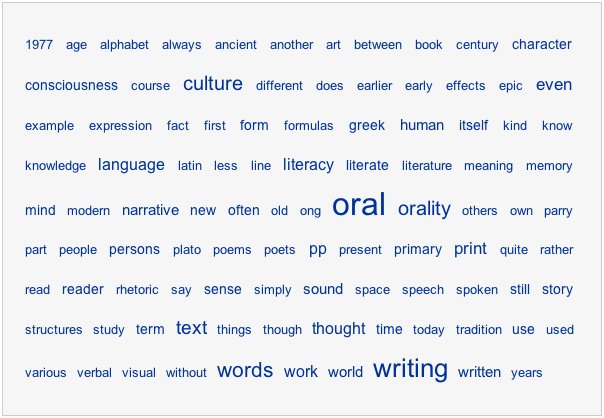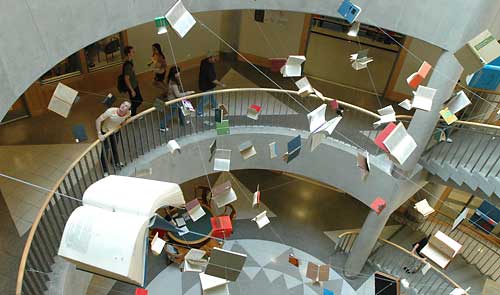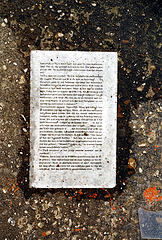
![]() This tree is made of all the pages, links and data on our site – built with a cool processing applet on texone.org (via reBlog ).
This tree is made of all the pages, links and data on our site – built with a cool processing applet on texone.org (via reBlog ).
“tree accesses the source code of a web domain through it’s url and transforms the syntactic structure of the web site into a tree structure represented by an image. this image illustrates a tree with trunk, branches and ramifications. first each tree is initialized, than all html links are detected, chronologically saved and finally displayed.”
It also builds separate trees for external links, creating entire forests of information. For some reason, our one external tree was a stubby, brown little runt for worldbook.com/info, which I’m pretty sure we do not link to, so I’ve left it off. I’m not sure why it didn’t pick up on our real external links. I’m also not sure exactly how to read the tree, but I guess I can see the basic nature of if:book represented – i.e. a blog is pretty simple structurally but with a lot of content, hence our shaggy, dense foliage on a slender trunk. I also made trees for Google and the New York Times and they were much less woolly and not green like ours.
The texone guys have also recorded the sound of data forests growing. Apparently, every node on a tree – each trunk segment, branch, and leaf – emits a piece of MIDI data – a digital note, varying in pitch according to placement on the tree (high notes are toward the top). They recorded the output for different trees and filtered it through various sound palettes (different types or arrays of instruments). A couple of examples are posted on their site. I’ve put one of them below.
Monthly Archives: April 2005
amazon: inching toward semantic

Sometime in the last few days, Amazon.com unveiled three new features for its Inside the Book search: “books on related topics,” a “100 most frequently used” concordance (above is the concordance for Orality and Literacy by Walter J. Ong), and “text stats.” The stats are pretty funny – in addition to page, word and character count, they measure a book’s “complexity” as well as its “readability” according to three established indexes, including the famous and amusingly named “Fog Index” (as though it rated the density of mental fog between a reader and a book). It also includes so-called “fun stats” like words per dollar and words per ounce.
Some of these features seem a little trivial, but there’s no denying that Amazon is moving surely and steadily toward a comprehensive semantic browsing system (other recent innovations are Statistically Improbable Phrases (SIPS) and Citations). Though still crude compared to what it might eventually become, you can begin to glimpse the pleasures and uses it will afford. Amazon can never replace the social and tactile pleasures of browsing a physical bookstore, but it’s doing a good job at making the virtual bookstore a more exciting place.
contagious media: symptom of what’s to come?
Here’s a rare peek into the inner workings of the institute: our discussion about viral media that came out of a debate over what to do with the Gates Memory Project. I’ve excerpted from last night’s email conversation….
Ben starts by saying:
Genesis and entropy are both accelerated on the web. Within moments, you can get something out there and have everybody talking about it. But the life can drain out just as quickly. I think it’s fair to say that energy [for the Gates Collective Memory project] is waning, but by refocusing on a single goal, we can perhaps keep this thing afloat…
Bob replies:
absolutely do not want to stop yet; haven’t done enough to have any lasting impact;
Dan says:
Not to derail the conversation by dragging into the realms of the meta, but might the arc that Ben’s describing (an initial flair-up of interest, followed by declining returns) be interesting in & of itself? It seems like the internet is very good at blowing up interesting things at the moment (viz: the contagious media thing Kim forwarded), but it’s (generally) not very good at sustaining interest (or scrutiny). (A major & significant exception: when a community springs up around something.) Occasionally you get a “where are they now?” thread on Boing Boing or Slashdot or something, but that’s very much the exception & not the rule.
This is maybe something that’s important if we’re considering the future of books. The information arc of the printed book seems to be very different: if there’s not a media circus around the launch of the book, there’s a very slow pickup, lasting, conceivably, a very long time. Electronic media seem to be much more time-sensitive.
Bob replies:
EXCELLENT point!
Dan says:
But not a particularly novel one. Certainly someone’s done some thinking about this? I’m not sure where to start looking . . .
Kim says:
Some ideas of where to start looking:
Eyebeam’s Contagious Media Experiments
Exhibition at the New Museum of Contemporary Art / Chelsea
CONTAGIOUS MEDIA
April 28 – June 4, 2005
Media Lounge
Review/preview of show
Dan replies:
This is kinda the opposite of what I’m interested in here. I think it’s great that the Internet spreads things virally, but these things burn out very quickly: the Peretti’s projects seemed “yesterday” a couple years ago. Nobody checks into blackpeopleloveus.com regularly – people visited once & got the joke (or didn’t). Do we really need a loving history of “all your base are belong to us”? It was funny – and certainly signifies a moment of our collective interaction with the Internet very precisely – but a museum exhibitions seems almost beside the point. You don’t put a pop song into a museum – and I say that with a full appreciation of pop songs.
To carry the pop song analogy further: in a pop-song world, can you have Bach? if you wanted to have Bach?
(I don’t think The Gates really fit into this sort of framework, because there were personal interactions with them. Ben – for example – can tell stories about the gates in a way that we can’t really tell (interesting) stories about the dancing baby.)
Kim replies:
Social critiques like www.whatisvictoriassecret.com which posed women in sexy underware barfing over the toilet really did say something about body image and the way the advertising industry manipulates women. And the Nike sweatshop emails forced Nike to address labor issues. These websites are not built to last in the same way oil paintings and poems are, but I do think they are a significant cultural commentary and a new form of activism. In this sense I suppose, the Gates do not fit, because they have no political goals.
We should also consider contagious media that parodies an over-hyped current event, a good example is this blog written by Brittany Spears’ fetus Don’t forget, the most popular website about the Gates was a parody (the Sommerville Gates). it followed this formula, went viral and got tens of thousands of hits.
I think the contagious media element is important for our project. The Gates themselves were temporary and the material we are gathering is, ostensibly, finite (i.e. Nobody is going to go out and take a picture of the Gates tomorrow). Therefore, we need to draw attention to the project now. I don’t think personal interactions or the potential for stories/complexity prevents us from making at least some part of this project contagious.
I don’t get the pop-song analogy. We do have museums for pop-music. Jazz, Motown, Elvis, the Beatles, they are not trivial and we still have Bach.
Ben says:
I agree it would be interesting to look at the project in terms of its arc – a web arc versus a print arc. It might be interesting also to consider this in terms of closed and exposed. Writing a book is a relatively solitary and contained act (unless it’s built on interviews and field research). But still, a work in progress is usually kept very private and tucked away. Only upon being published does it open up to the world. Our project, however, started with a large number of people and a fair bit of attention, but then gradually contracted to an inner core. Now we try to make sense of that dizzying encounter with the larger world. You could say that print books embody thinking before speaking, whereas the web fosters speaking first and thinking later, or not at all.
As for Bach, I think he’s pretty much impossible in a pop world, except as reduced to a pop song – the played-to-death cello suite accompanying a Lexus gliding across your TV. Someone today with Bach’s genius probably couldn’t impact the development of music in nearly as big a way. Maybe he would just become a scientist. And it’s true, we don’t really put pop songs in museums. Only one of the things Kim mentions is a place, and that’s a museum to a legendary person, not a song. I suppose there’s the rock and roll hall of fame, but that strikes me as going to the taxidermist’s and calling it a zoo. I guess what I’m trying to say is that there’s a similar entombed quality to this Contagious Media Showdown Eyebeam is hosting. It’s proof that the “all your base,” “blackpeopleloveus” variety of web contagion is passé. Drag racing diseases isn’t subversive, it’s just referential. But I agree with Kim that there continue to be interesting and sometimes powerful instances of contagious media. But a big part of their power is that they come out of nowhere. The minute you announce that something is contagious, you kind of kill its coolness. I wonder if anything worthwhile will come out of that contest.
It’s interesting to analyze all this in terms of trying to make something coherent and lasting on the web. But I’m not sure we need to lob a contagious grenade of our own. What sort of thing are you imagining?
–end of email exchange, conversation continues in the comment field–
hub media
Another grassroots media experiment has sprung up in the hinterlands: YourHub.com, a cluster of community portals in the greater Denver metropolitan area that, like Bluffton Today, invites users to forge their own local news from submitted stories, images, ads and events listings. And like its South Carolina counterpart, YourHub is being launched by a larger media company, The Rocky Mountain News.
(via Dan Gillmor)
boekplaats
books lighter than air

A new installation by J. Ignacio Diaz de Rabago in the atrium staircase of the Gardner stacks at Berkeley’s Doe Library (photograph from UC Berkeley News). Other works by Diaz de Rabago can be viewed here, including his multi-part “Babel” series, to which his latest presumably belongs.
(via Conversational Reading)
out of print is out of date
Amazon.com has recently acquired BookSurge, the self-described “global leader in inventory-free book publishing, printing, fulfillment and distribution.” This adds cutting edge print-on-demand technology to Amazon’s online retailing recipe – big news for self-published authors, but even bigger news for readers. Amazon’s move suggests that print-on-demand might finally be maturing out of the terrible twos of the vanity press into a technology that redefines publishing in space and time. Imagine rare books suddenly coming back into print, and newer books staying in print longer, or indefinitely. Every book, no matter how old or obscure, could theoretically be in print, in perpetuity. Amazon already sells out-of-print or hard-to-obtain titles produced on demand by BookSurge, but their absorbing the company signals a definitive step futher into long tail bookselling. (article)
The backbone of any serious publishing house used to be its backlist – the large catalogue of older titles that sell reliably over time and are therefore kept in print. A backlist might include classics by the country’s most important authors, or books with more modest readership that still sell consistently over the years. It’s like the publisher’s DNA – a map of who they really are. On occasion, you have a runaway bestseller, and you rejoice, but it’s not something you count on. It’s the sturdy, distinguished backlist that keeps a publisher grounded. Today we have the opposite. Most publishing houses have merged under large media conglomerates, backlists have dwindled, and publishers are ever more obsessed with finding their next blockbuster hit – a Dan Brown or Sue Grafton. Books quickly go out of print, and many more – books that might have found a smaller, more select readership – probably never see the light of day since publishers aren’t willing to take on the cost and risk of a smaller print run.
But as Greg Geeley, Amazon.com media products vice president, puts it:
“Print-on-demand has changed the economics of small-quantity printing, making it possible for books with low and uncertain demand to be profitably produced… Thanks to print-on-demand, ‘out of print’ is out of date.”
People have been talking for some time about the internet’s potential to sweep away the stagnation of mainstream publishing. Amazon has already changed the way we browse, buy and discuss books. Now, with machines that can turn out a single book at a time, indistinguishable in appearance and quality from a regular trade paperback or even hardcover, no title need ever go out of print, and publishers might finally be able to direct their attention away from quantity and back to quality.
For further reading…
wireless fairy tales
Kids in Denmark may soon be reading Hans Christian Anderson on their cell phones. To celebrate the writer’s bicentennial, a Danish company is releasing an interactive comic book series designed specially for the tiny screen.
(via textually.org)
simple answers to simple questions
Looking for simple facts on the web can be a frustrating business. Over time, we bookmark sites that reliably deliver the goods – things like basic geographical data, conversion scales for measurements, biographical summaries, or anything else that we need to quickly grab, plug in, and move on. But it all takes much longer than it should, and in looking for such things, we’re plagued as much by the nuance of internet search as by its imprecision. It’s all part of learning how to deal with this massive web we’ve created, and the state of blindness to which it reduces us. Search engines are really the only tool we have for groping through a pitch black sea of information, where the ineluctable modality is meaning, not the visible (for more on this, read Steven Pemberton’s talk from the Decade of Web Design conference, which if:book attended this January in Amsterdam).
Well Google has helped us to see, just a little bit better, the little nuggets and factual crystals that we so often sift for in our blindness – by unveiling a new Q&A feature for basic web search (article via Bibliotheke). Plug in a search like “earth distance sun,” or “copernicus date of death,” and you get exactly what you’re looking for right above the stack of general results:

or

It’s the kind of small, thoughtful innovation that makes you appreciate Google’s attention to detail and sensitivity to the problem of blindness. Other search engines like Ask Jeeves offer a similar feature, but Google includes the information’s source (a source they’ve vetted and deemed reliable) and a link to that page. For example, in the case of basic geography and demographics, the link might be to the CIA’s World Factbook. Even if you just grab the fact and run, it’s comforting to have seen a trustworthy citation, though some might grumble about the CIA.
It would be fantastic if this kind of quick fact extraction could be tailored to different search needs. Imagine a “writer’s search toolbox” combining every conceivable reference resource that an author might need. Enter “synonym for think” and right at the top you get an entire thesaurus search result: “analyze, appraise, appreciate, brood, cerebrate, chew, cogitate, comprehend, conceive….” Enter “idiom with humble” and you get “eat humble pie,” “Be it ever so humble, there’s no place like home,” etc. Or search for rhymes, poetic forms, grammar guidelines, literary terms, writer bios, quotes, etymologies – anything. It’s good news that search is being refined in this way, and competition among giants seems, in the end, to be good for the average web browser. Whatever helps us spend less time scouring and more time on the things that are important to us.
the kids are good to go: media literacy and the next generation
What would happen if you gave a computer to a group of under-educated kids who had never seen one before? Answer: they would figure out how to use it, all by themselves. Immediately. This is the surprising result of what has come to be known as “the hole in the wall experiment,” conducted by computer scientist, Dr. Sugata Mitra. Dr. Mitra put a computer with internet access in a hole in the wall outside his New Dehli office. According to an article in FRONTLINE/World, “He wanted to see who, if anyone, might use it. To his delight, curious children were immediately attracted to the strange new machine.” All of these children lived in the surrounding slum and had never seen a computer before. However, “Within minutes, children figured out how to point and click. By the end of the day they were browsing. “Given access and opportunity,” observes O’Connor, “the children quickly taught themselves the rudiments of computer literacy.”
The children even developed their own names and associations for the computer icons “They don’t call a cursor a cursor, they call it a sui, which is Hindi for needle. And they don’t call the hourglass symbol the hourglass because they’ve never seen an hourglass before. They call it the damru, which is Shiva’s drum, and it does look a bit like that.”
But the slums of New Dehli are not unique, priviledged kids are also enthusiastic about computers. According to a recent report called “Born to Be Wired”. teens and young adults spend more time using interactive technology than they do watching television. This could mean that are ready for a more interactive and self-guided experience in the classroom. Wise use of media in the curriculum should find ways to exploit this new hunger and allow kids to participate in ways we couldn’t imagine in the past. Jonathan Schwartz, CEO of Sun Microsystems, is calling this “The Participation Age,” a new paradigm for collaborative content creation that seems destined to influence our top-down educational system. The question of how to teach media literacy to kids who seem to grasp these principles intuitively and instantaneously, seems answerable only with a paradigm shift in educational models. Perhaps educators should become more like guides or support persons, providing educational resources and mentor-like advice, empowering kids to engage in self-motivated learning experiences.



